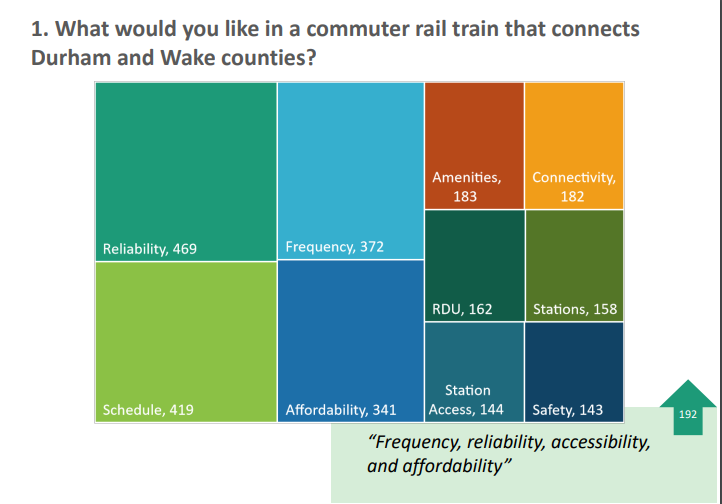RESEARCH TRIANGLE PARK (APRIL 29, 2021) – Asked to offer feedback on plans for a Triangle commuter rail line, more than 2,700 community members responded with nearly 5,000 comments, an outpouring that underscored the high level of interest in the transformative project slated to run from West Durham through downtown Raleigh to Garner or Clayton.
Today, in response to the public’s clear desire to stay up to date on the project, GoTriangle is launching the new project website Ready for Rail NC at readyforrailnc.com.

On the site, anyone can sign up to become a Commuter Rail Insider and receive email alerts with news updates and engagement opportunities. There also is information on the history of the project , survey results, proposed station sites, answers to frequently asked questions and videos about other successful rail projects in the United States.
“We are in a study phase for the project, and planners will be using community feedback to help refine the initial project concept,” Lattuca says. “We’ll house all this information on the website, so sign up as a Commuter Rail Insider and you’ll be notified when updated information is published.”
Project stakeholders include residents, transit riders, the business community, local governments, universities and other institutions and major employers along the rail line as well as the North Carolina Railroad Company, North Carolina Department of Transportation Rail Division and operating railroads including Norfolk Southern and CSX.
Planners also are analyzing the economic and land-use benefits commuter rail would bring to the Triangle and the state.
The major takeaways
During the comment period last fall, community members had the opportunity to answer these questions about the project:
- What would you like in a commuter rail train that connects Durham and Wake counties?
- What do you see the commuter rail train doing for your community?
- At the end of this study, local leaders will decide whether to move forward with the proposed commuter rail train. What else should they be considering to make that decision?
GoTriangle, which worked with a consultant to record and organize the thousands of comments, determined some major takeaways. Community members expect the project to decrease commute times, benefit the environment, bring the Triangle up to modern metropolitan standards and foster a sense of connectivity throughout the region. The major concern cited was cost, previously projected to be $1.4 billion to $1.8 billion.
More information about the survey results can be found on the new website here.
An earlier study found that a 37-mile route running 40 times a day between Garner and West Durham would be most likely to qualify for federal funding, which can pay up to half of the project’s cost.

- “Reliability, easy access to stations, frequent trains, needs to be shorter time-wise than car.”
- “Wi-Fi, electrical outlets, comfortable seating, access to airport and RTP, convenient parking, frequent schedule.”
- “Frequency, reliability, accessibility, and affordability.”
For the question about what a commuter rail train might do for the community, the answers included:
- “Easing congestion and pollution. Providing opportunities for all people to travel without a car. Be able to go to downtown Raleigh without dealing with parking.”
- “Provide competitive alternative to driving to work every day, avoiding and mitigating increasing vehicular congestion. Provide a resource to ensure Triangle area continues to be competitive in attracting business growth well into the future.”
- “Improve access to transit, support economic development of walkable, mixed-use zones around stations, increase sustainability, better access to opportunities for zero-car households.”
“It’s important to note that 87 percent of the answers to the question of what the commuter rail train might do for the community were positive, especially among minority respondents,” Lattuca says. “In fact, 90 percent of all minority respondents and 95 percent of minority respondents in Durham County gave positive answers. This commuter rail project has broad appeal in the Triangle.”
The next steps
At the end of the current study phase, local elected officials, including the boards of commissioners for Wake and Durham counties, will decide whether to seek federal funds and begin final design and construction.
For what those decision-makers should be considering, survey answers included:
- “We need to catch up with other regional metropolitan areas like Charlotte and Atlanta to stay relevant for industries and businesses considering relocating to the Mid-Atlantic or Southeast U.S. Mass transit will be the way of the future and if not now then when?”
- “Cost is obvious but thinking long term and acting in a progressive spirit. If we want to be a major employer and “best place to live” city, public transportation is a necessity. “
- “I think that the local leaders have to act in the best interest of those who have little influence in the process (the poor who probably most need public transport). We can't keep building bigger roads.”
“Our wonderful region continues to attract more residents and more businesses, making our commuter rail project more important by the day,” says Lattuca, left. “A Triangle commuter rail line between West Durham and Raleigh extending to Garner or Clayton presents an opportunity to manage growth and create a truly regional transit network, which will help us build upon our standing as one of the best places to live and do business in the United States.”
Lattuca pointed to the announcement this week that Apple plans to spend $552 million to establish a campus in Research Triangle Park with 3,000 high-paying jobs.
“The more attractive we are, the more we are going to need transit solutions to maintain our quality of life,” Lattuca says. “Global companies like Amazon, Google and Apple have corporate goals about shrinking their carbon footprints as well, and building environmentally friendly mass transportation like commuter rail to connect the Triangle is going to be imperative to maintaining our appeal.”
